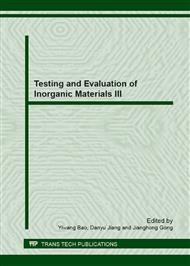p.187
p.191
p.196
p.200
p.205
p.209
p.213
p.219
p.226
Textural Properties of Nanocrystalline Hydroxyapatite Synthesized via a Microwave-Hydrothermal Process
Abstract:
Textural properties of nanocrystalline hydroxyapatite (HAP) prepared by microwave-hydrothermal (M-H) method have been comparatively studied as a function of synthesis conditions. Field emission scanning electron microscopy measurement reveals that the material is composed of rod or prism-like nanoparticles. N2-sorption analysis shows that the as-prepared HAP samples are textural mesoporous materials. The porous networks of aggregated nanoparticles are derived from the interparticle space. HAP samples prepared at 100 °C for 30 min exhibited a narrow pore size distribution with a high surface area (up to 92 m2g-1). As the increase of synthesis temperature and/or time, the total pore volumes and surface areas of the HAP samples decrease, the pore size distributions become broader. It was observed that the textural evolution of the products is closely related to its crystallite size. The present study shows the microstructural features of nano HAP powders can be tuned by synthesis conditions.
Info:
Periodical:
Pages:
205-208
Citation:
Online since:
March 2013
Authors:
Keywords:
Price:
Сopyright:
© 2013 Trans Tech Publications Ltd. All Rights Reserved
Share:
Citation:


